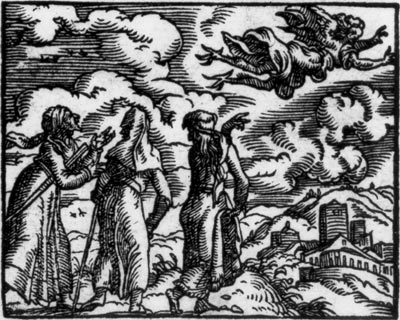
Power and Belief, 1300-1750
 |
Witches in Europe
Power and Belief, 1300-1750 |
Chronology
Early Trials: 1300-1500
| Phase 1: 1300-1330
A low rate of prosecution for witchcraft; slightly more than half of all prosecutions are in France, the rest in England and the Empire; allegations are generally mild; most are political in nature; sorcery is the prominent charge. |
1315-1317 The Great Famine
1322-1323 Expulsions of Jews from
southern France
1324
Trial of Alice Kyteler (Kilkenny, Ireland)
| Phase 2: 1330-1375
The rate of prosecution falls slightly; most prosecutions are in France; political trials all but vanish. As in phase one, few accusations of diabolism. |
1348-1349 The Black Death
1368
Nicolas Eymeric, Directorium Inquisitorum.
1380
Trials of Waldensians in the western Alps
1384
Trials of 'Luciferans' in Brandenburg.
| Phase 3: 1375-1435
Two shifts: (a) Steady increase in the number of trials; (b) greater concern with diabolism steadily increases; spread of inquisitorial procedure; decline of talion (i.e., harsh penalties for false accusation); decline in number of men accused of sorcery. |
ca. 1400
Witch trials in Lausanne under Peter von Greyerz (Switzerland)
1428
Witch-trials in the Valais (Switzerland)
1430-1431 Trial of Joan of
Arc
| Phase 4: 1435-1500
Sharp increase in the number of trials, especially in Switzerland, but also in France and the Empire generally; trials in Italy; full formation of the learned stereotype of the witch; women a majority among people accused of witchcraft; especially intense prosecution in 1455-1460 and 1480-1485. |
1437
Johannes Nider, Formicarius (recounts the trials at Lausanne)
1484
Innocent IV, Summis desiderantis.
1486
Jakob Sprenger and Heinrich Kramer, Malleus Maleficarum.
1499
Royal suspension of Waldensian persecution in France.
1490
King Charles VIII of issues an edict against fortunetellers, enchanters,
necromancers and others engaging in any sort of witchcraft.
Reform-Era Interlude, 1500-1550
1529
Inquisitorial witchcraft trials take place at Luxeuil.
1532
The Constitutio Criminalis Carolina imposes the penalties of torture
and death for witchcraft.
1539
The Statute of Villers-Coterets authorizes the use of judicial torture
in France.
1542
Henry VIII issues a statute against witchcraft.
1547
Repeal of statute of 1542 in reign of Edward VI.
The High Point of Witchcraft-Prosecution, 1550-1650
1563
Queen Elizabeth issues a statute against witchcraft.
1563
Johann Weyer, De praestigiis daemonum.
1565-1566 Possession of Nicole
Obry, Vervins (Picardy)
1566
The first Chelmsford witch trials, the first to appear in a secular court
in England; execution of Agnes Waterhouse.
1579
The Windsor witch trials; also the second Chelmsford trials.
1580
Jean Bodin, Daemonomanie des sorciers.
1581-1593 Witch prosecutions in the Archbishopric
of Trier
1584
Reginald Scot, The Discoverie of Witchcraft.
1589
Third Chelmsford witch trials.
1589
Fourteen convicted witches at Tours appeal to King Henry III, who is in
turn accused of protecting witches.
1590
Witch trials in Bavaria under Duke Wilhelm V the Pious
1590-1591 The North Berwick witch
trials in Scotland.
1593
Warboys witches of Huntingdon put on trial.
1594
Conviction of Senelle Petter in Lorraine.
1595
Nicolas Rémy, Demonolatry.
1597
Publication of Daemonologie by James VI of Scotland (later James
I of England).
1597
Bewitchment of Thomas Darling and trial of Alice Gooderidge.
1604
Witch Statute of James I.
1605
Abingdon witches and Anne Gunter.
1609-1611 Convent possession in
Aix-en-Provence
1611-1613 Mass witch trials in
the Imperial Provostry of Ellwangen.
1612
Lancashire witch trials.
1616
Case of the Leicester Boy (John Smith).
1625
Start of general decline of witch trials in France.
1628
Trial of Johannes Junius, mayor of Bamberg, for witchcraft.
1629
Witch trials in the Bishopric of Würzburg.
1631
Cautio criminalis published anonymously by Friedrich von Spee.
1632
Death of the Prince-Bishop of Bamberg marks the end of the terrible persecutions
in this large principality (1609-1632).
1632-1640 The convent possession
at Loudun.
1643-1647 Convent possession in
Louviers.
1645
Case of the Faversham witches, Kent Witchfinder-General Matthew Hopkins
and the Chelmsford (or Manningtree) witch trials.
1647
Publication of Discovery of Witches by Matthew Hopkins.
1649
Case of the St. Albans witches, Hertfordshire.
Decline, Transformation, and Disappearance, 1650-1750
1652
Trial of Suzanne Gaudry
1652
"Dr. Lamb's Darling": the trial of Anne Bodenham rial of the Wapping Witch
(Joan Peterson) near London.
1655
Last execution for witchcraft in Cologne (where persecution less severe).
1662
The Bury St. Edmunds witch trials.
1670
Rouen witch trials.
1674
Trial of Anne Foster in Northampton.
1679-1682 The Chambre d'ardente
affair:
investigation of poison plots and witchcraft leads to 300 arrests and 36
executions; ends with royal edict denying the reality of witchcraft and
sorcery.
1736
Repeal of Statute of James I (1604).
1787
All witchcraft laws in Austria are repealed.
| Country or Region | Last Execution | Last Trial |
| Parlement of Paris (northern-central France) | 1625 | 1693 |
| Alsace (borderland with the Empire) | 1683 | 1683 |
| Franche-Comté (eastern France) | 1661 | 1667 |
| Cambrésis (northern France) | 1679 | 1783 |
| Dutch Republic | 1609 | 1659 |
| Luxembourg | 1685 | 1685 |
| Switzerland | 1782 | 1782 |
| England | 1684 | 1717 |
| Scotland | 1706 | 1727 |
| Ireland | 1711 | 1711 |
| New England | 1692 | 1697 |
| Denmark | 1693 | 1762 |
| Sweden | 1710 | 1779 |
| Finland | 1691 | 1699 |
| Württemberg (southwestern Empire) | 1749 | 1805 |
| Westphalia (northwestern Empire) | 1728 | 1732 |
| Würzburg (central Empire) | 1749 | 1749 |
| Bavaria (southern Empire) | 1756 | 1792 |
| Augsburg | 1728 | 1738 |
| Nuremberg | 1660 | 1725 |
| Prussia | 1714 | 1728 |
| Austria | 1750 | 1775 |
| Hungary | 1756 | 1777 |
| Poland | 1775 | 1776 |
| Spain | 1781 | 1820 |
| Portugal | 1626 | 1802 |